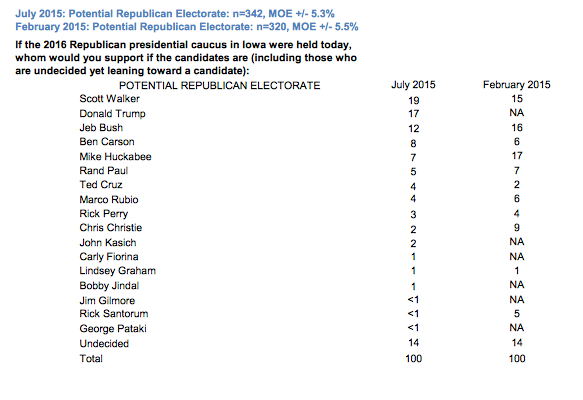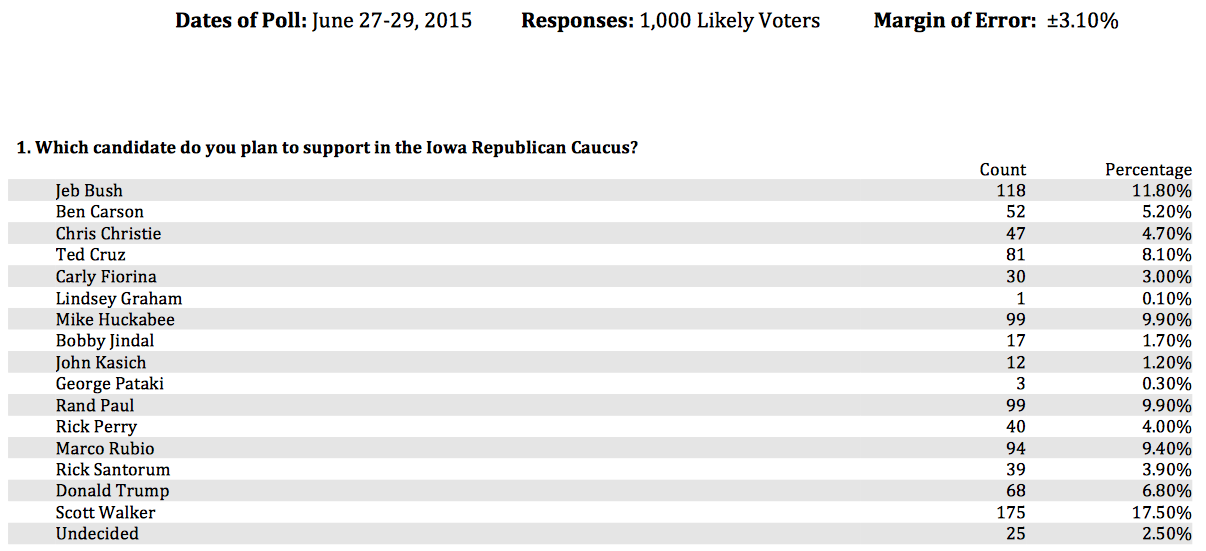What’s on your mind this weekend, Bleeding Heartland readers? This is an open thread: all topics welcome.
The Americans With Disabilities Act took effect 25 years ago this week. How many laws have changed the country for the better as much as Senator Tom Harkin’s greatest achievement? The ADA helped millions of people who might have been housebound–like my friend who was able to run errands or take her son to the park, even though she was confined to a wheelchair. Judy Schmidt, who chairs the Iowa Democratic Party’s Disability Caucus, shared how the ADA has affected her in a guest column for the Cedar Rapids Gazette. I’ve enclosed excerpts after the jump. Bleeding Heartland posted more background and links about the law to mark its 20th anniversary. For the record, Iowa’s senior Senator Chuck Grassley also voted for the final version of the ADA, as did most of his fellow Republicans. UPDATE: Added below excerpts from Harkin’s guest editorial in the Sunday Des Moines Register.
Donald Trump has led the last five national polls of Republican voters and is rising in stature in Iowa, if you believe the latest surveys of likely GOP caucus-goers. Follow me after the jump for details.
I brought my kids to Bernie Sanders’ town-hall in West Des Moines on Friday night. My reflections on that event are at the end of this post.
NBC/Marist released its latest early-state polls this morning, showing Trump at 17 percent in Iowa, a close second to Wisconsin Governor Scott Walker (19 percent). Full results are from the NBC/Marist poll are here; this table shows the toplines.
Monmouth University’s Iowa poll released on July 20 also showed Trump placing second among GOP caucus-goers, further behind Walker than what NBC/Marist found. Only some of the respondents for that poll were surveyed after Trump’s controversial comments about John McCain. Click here for the Monmouth University polling memo. I enclose this chart showing the toplines:
By the way, Monmouth University is in New Jersey. Its polls are not conducted by the same people who released a “We Are America” Iowa caucus poll in early July on behalf of Monmouth College (Illinois) and KBUR in Burlington. You can find the full results for that survey of Iowa Republicans here. This chart shows the toplines:
Trump turned out a big crowd in Oskaloosa yesterday. Dave Weigel’s write-up for the Washington Post is an entertaining read. I haven’t weighed in on Trump’s various ridiculous comments or his feud with the Des Moines Register, because I don’t feel I have much to add to the conversation. I agree with Jon Stewart and others who have noted that most GOP establishment figures didn’t condemn Trump (nor did the Register call on him to quit the presidential race) until he said something offensive about John McCain–as if that’s worse than slandering Mexican immigrants as a bunch of rapists. I still view Trump as a clown who will peak too soon. If he finishes in the top three on Iowa caucus night, I’ll be shocked.
Bernie Sanders continues to draw the largest crowds in Iowa–including roughly 1,200 people in West Des Moines on Friday–and polls indicate that he is cutting into Hillary Clinton’s lead among likely Democratic caucus-goers. The new NBC/Marist poll found, “Clinton leads Sanders by 29 points, 55 percent to 26 percent, with Martin O’Malley at 4 percent and Jim Webb at 2 percent. In a February NBC-Marist poll of the Hawkeye State, Sanders was just 7 percent in a field that also included Vice President Joe Biden, who isn’t expected to run for president.” Monmouth University didn’t conduct a separate poll of Iowa Democrats this month but found Sanders gaining among Democrats nationally. The Monmouth College/KBUR poll of Iowa Democrats, conducted in late June, showed Clinton at 63 percent support, followed by Sanders (20 percent), undecided (8 percent), O’Malley (5 percent), Webb (3 percent), and Lincoln Chafee (1 percent).
I don’t think there is any real chance of Sanders beating Clinton in Iowa, but his message is resonating with a sizable part of the Democratic base, as anyone could see on Friday night during his town-hall meeting at West Des Moines Valley High School. I challenge any Democrat to find one substantive point to disagree with in Sanders’ stump speech. Many people who attend his events are already “feeling the Bern.” My impression is that the undecideds who show up walk away giving him their serious consideration. I doubt anyone leaves a Sanders event thinking, “I could never caucus for that guy.”
Listening to Sanders on Friday, I was again struck by the senator’s distinctive way of speaking. He packs a lot of facts and figures into his remarks without sounding wonky. He conveys a lot of passion without raising his voice often. Compared to many candidates, he says very little about his children and grandchildren. Still, his feelings about family come through loud and clear when he contrasts Republican ideas about “family values” (a “woman shouldn’t be able to control her own body”) with what family values should mean (for instance, a mom and dad having paid time off from work so they can get to know their new baby). Although the Sanders stump speech is overly long–pushed well past the one-hour mark by many interruptions for applause–he keeps his listeners’ attention. Even my 12-year-old was still engaged with the content, right up to the end. (My 9-year-old checked out mentally after 30 to 45 minutes.)
Any relevant comments are welcome in this thread.
From Judy Schmidt’s guest column for the Cedar Rapids Gazette on July 25, “Happy Birthday ADA”:
Seven years ago, I was diagnosed with a physical disability. If this had happened before the ADA, it would have been incredibly difficult for me to find a job. But the ADA forbids discrimination based on disability, and requires employers to make reasonable accommodations for employees with disabilities. Because of this landmark legislation, I am able to teach ESOL part-time at Northeast Iowa Community College. I am able to give back to my community.
That’s why the ADA is so historic. It’s not just about handicap parking spots and curb rails and closed captioning and wheelchair accessible public buses – although those are incredibly important to the disability community.
What makes the legislation so monumental is that it empowers people with disabilities with the confidence to know our contributions matter. That people with disabilities are judged, as Sen. Harkin said 25 years ago, “on the basis of their abilities, and not on the basis of their disabilities.”
That’s the biggest success of the ADA, though there are many others as well. Between 1996 and 2005, the percentage of students with disabilities who graduated with a high school diploma increased from 43 percent to 57 percent. Products, public buildings and spaces are now regularly designed for the most people to be able to use them.
UPDATE: From Senator Tom Harkin’s guest editorial in the July 26 Sunday Des Moines Register, “The Disabilities Act at 25: Challenges remain.”
Too many people with disabilities continue to live in poverty, at more than twice the rate of the general population. Jobs for people with disabilities are much more difficult to come by. The workforce participation rate of people with disabilities is still less than half that of the general population, despite over 80 percent of people with disabilities reporting they wish to work.
Other challenges continue to exist as well. Housing in most areas of the country is not accessible to people with disabilities. Simple alterations in our building codes could make all new housing units “visitable” by all people and, again, help all of us with an aging family member.
Transportation is better than it was 25 years ago with buses and trains that are more accessible, but because of budget cuts there are fewer buses and trains and the hours they operate have been reduced. Such cut backs hurt the general population, but for people with disabilities such cuts remove the means for equal opportunity and employment.
In London today every taxicab is fully accessible. But not here in the United States. I have to ask why not?
Perhaps the most persistent problem that remains is attitude. When we worked to pass the ADA, we knew that we needed the American people to see the potential, the capacity, and the talent of people with disabilities. Today, more do see those possibilities but many of the general public still do not value the talent, creativity, and ability to work of people with disabilities.



